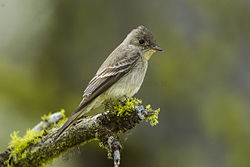From Wikipedia
Open on Wikipedia
| Western wood pewee | |
|---|---|

| |
| Scientific classification | |
| Kingdom: | Animalia |
| Phylum: | Chordata |
| Class: | Aves |
| Order: | Passeriformes |
| Family: | Tyrannidae |
| Genus: | Contopus |
| Species: | C. sordidulus
|
| Binomial name | |
| Contopus sordidulus Sclater, PL, 1859
| |

| |
Breeding Migration Nonbreeding
| |
The western wood pewee (Contopus sordidulus) is a small tyrant flycatcher. Adults are gray-olive on the upperparts[2] with light underparts, washed with olive on the breast. They have two wing bars and a dark bill with yellow at the base of the lower mandible. This bird is very similar in appearance to the eastern wood pewee; the two birds were formerly considered to be one species. The call of C. sordidulus is a loud buzzy peeer; the song consists of three rapid descending tsees ending with a descending peeer.
Description
[edit]Measurements:[3]
- Length: 5.5–6.3 in (14–16 cm)
- Weight: 0.4–0.5 oz (11–14 g)
- Wingspan: 10.2 in (26 cm)
Habitat and ecology
[edit]Their breeding habitat is open wooded areas in western North America. These birds migrate to South America at the end of summer. The female lays two or three eggs in an open cup nest on a horizontal tree branch or within a tree cavity; California black oak forests are examples of suitable nesting habitat for this species of bird.[4] Both parents feed the young.
Behavior
[edit]They often wait on a perch at a middle height in a tree and fly out to catch insects in flight (hawking), and will also hover to pluck insects from vegetation (gleaning).
References
[edit]- Cornell Lab of Ornithology: Western Wood-pewee Species Account
- C. Michael Hogan (2008) Quercus kelloggii, Globaltwitcher.com, ed. N. Stromberg
Line notes
[edit]- ^ BirdLife International (2016). "Contopus sordidulus". IUCN Red List of Threatened Species. 2016 e.T22699811A93748966. doi:10.2305/IUCN.UK.2016-3.RLTS.T22699811A93748966.en. Retrieved 12 November 2021.
- ^ Cornell Lab of Ornithology
- ^ "Western Wood-Pewee Identification, All About Birds, Cornell Lab of Ornithology". www.allaboutbirds.org. Retrieved 2020-09-27.
- ^ C. Michael Hogan, 2008
External links
[edit]- Videos, photos and sounds - Internet Bird Collection
- Photos Archived 2011-05-16 at the Wayback Machine - VIREO
- Photo-High Res[dead link]; Article – "Utah Birds"–(clickable Photo Gallery)
